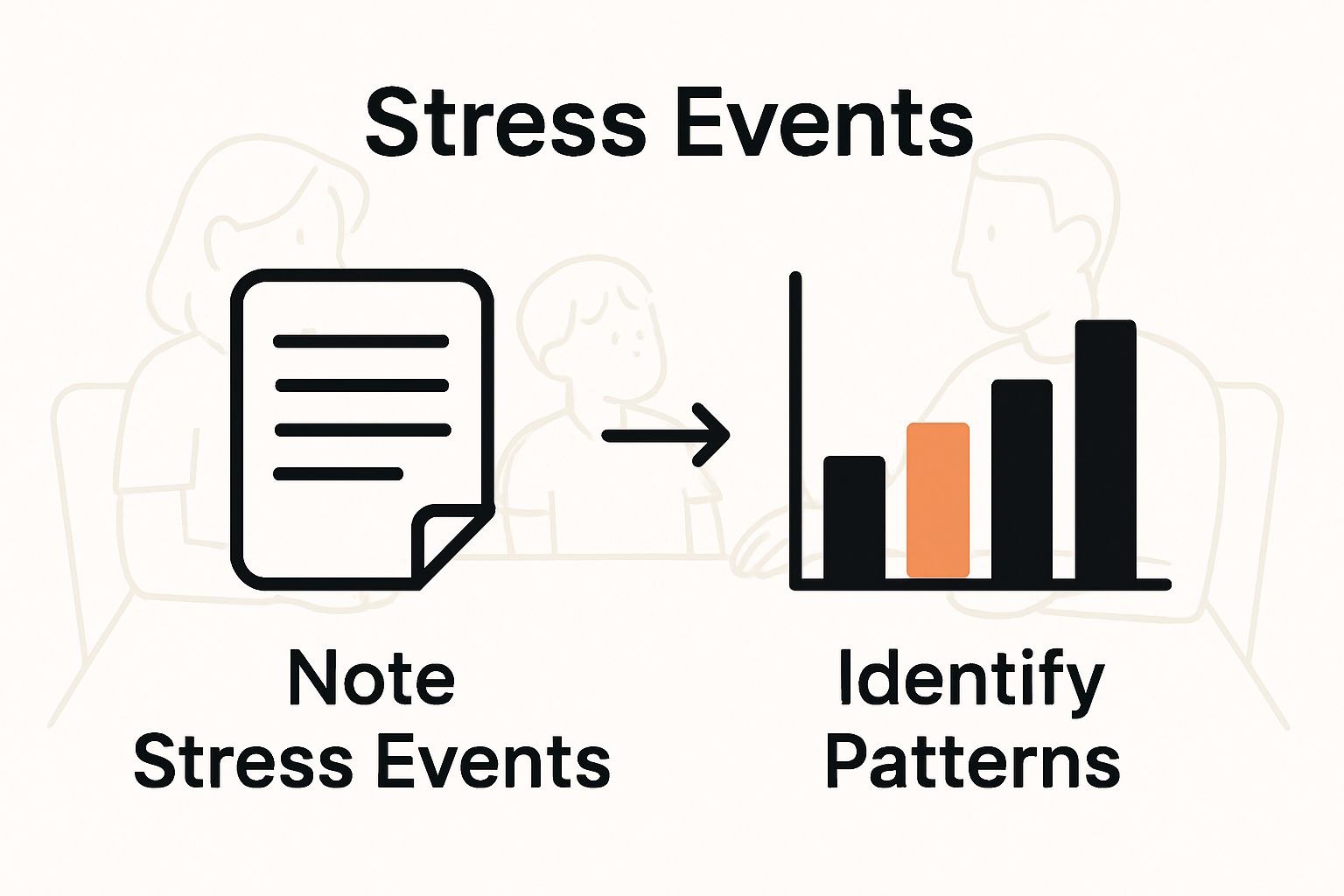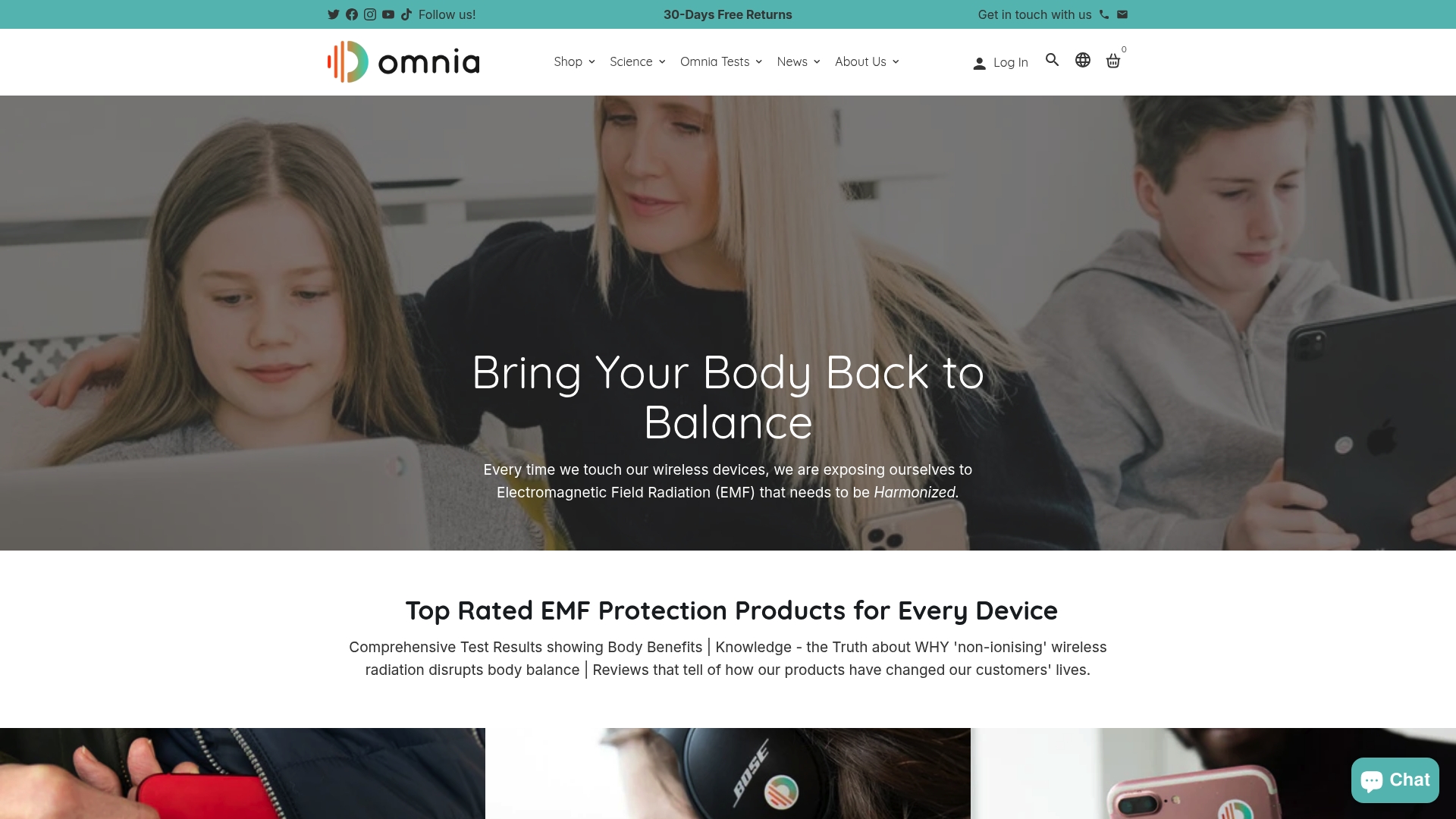Parenting stress sneaks up in ways you barely notice and sometimes it feels like you’re juggling a hundred tasks at once. Nearly 70 percent of parents report feeling stressed constantly, according to the latest national surveys. That sounds overwhelming, right? Most advice focuses on quick fixes or ignoring the problem but the real solution starts with understanding your own patterns and making a few bold but realistic changes that genuinely work for your everyday life.
Table of Contents
- Step 1: Identify Your Stress Triggers
- Step 2: Implement Mindful Breathing Exercises
- Step 3: Create A Digital Detox Routine
- Step 4: Establish Healthy Boundaries
- Step 5: Incorporate Physical Activity Daily
- Step 6: Evaluate Your Progress Regularly
Quick Summary
| Key Point | Explanation |
|---|---|
| 1. Identify your unique stress triggers | Keep a journal to track daily stressors and your responses for better self-awareness. |
| 2. Practice mindful breathing techniques | Use the 4-7-8 breathing method to calm your body and manage immediate stress effectively. |
| 3. Implement a digital detox routine | Set specific times for no-device zones to reduce chronic digital stress and enhance family interactions. |
| 4. Establish healthy boundaries | Clearly communicate your limits to protect your emotional energy and reduce stress. |
| 5. Incorporate daily physical activity | Engage in enjoyable movement to relieve tension and boost your mental health resilience. |
Step 1: Identify Your Stress Triggers
Understanding your unique stress triggers is a critical foundation for effective stress management. As a parent, you experience multiple simultaneous pressures that can create overwhelming emotional landscapes. Recognizing what specifically provokes your stress response allows you to develop targeted strategies for prevention and recovery.
The process of identifying stress triggers requires honest self reflection and careful observation. Start by creating a stress journal where you document daily experiences that generate emotional or physical tension. Note the precise circumstances surrounding these moments including time of day, specific interactions, environmental conditions, and your immediate physiological reactions.
Parents often experience stress from multiple interconnected domains such as work responsibilities, childcare challenges, relationship dynamics, financial pressures, and personal health management. Your stress triggers might emerge from unexpected sources like sleep deprivation, unmet expectations, communication breakdowns, or accumulated minor frustrations that compound over time.
As recommended by the American Psychological Association, track not just the event causing stress but your personal response patterns. Pay attention to physical signals like increased heart rate, muscle tension, shallow breathing, or digestive disruptions. Emotional indicators could include sudden irritability, feelings of being overwhelmed, anxiety, or unexpected mood shifts.
Key Observation Strategies:
- Record stress events within 24 hours of occurrence
- Note physical and emotional responses objectively
- Identify recurring patterns or common themes
- Assess the intensity of your stress reaction

Remember that stress triggers are deeply personal. What creates significant tension for one parent might seem insignificant to another. Your goal is developing self awareness without judgment. Approach this process with curiosity and compassion, viewing it as a valuable tool for understanding your unique stress response mechanism.
By meticulously documenting these experiences, you’ll gradually construct a comprehensive map of your stress landscape. This map becomes your strategic blueprint for developing personalized stress management techniques that genuinely work for your specific life circumstances.
Here is a summary checklist to help you implement daily stress management techniques effectively:
| Stress Management Technique | Implementation Tip | Frequency | Key Outcome |
|---|---|---|---|
| Identifying Stress Triggers | Keep a daily stress journal | Ongoing | Greater self-awareness |
| Mindful Breathing Exercises | Use the 4-7-8 method during stressful moments | Multiple times daily | Rapid emotional regulation |
| Digital Detox Routine | Set device-free zones and times | Daily | Reduced digital-induced stress |
| Establishing Healthy Boundaries | Communicate needs clearly to others | As needed | Protection of emotional energy |
| Physical Activity | Integrate quick, fun movement into your day | Daily | Stress release and resilience boost |
| Progress Evaluation | Schedule regular review sessions | Monthly/Quarterly | Tracking improvement and adaptation |
Step 2: Implement Mindful Breathing Exercises
Mindful breathing represents a powerful stress management technique that transforms how your body responds to emotional and physical tension. After identifying your stress triggers, implementing deliberate breathing strategies provides an immediate mechanism for emotional regulation and nervous system recalibration.
Breathing is more than an automatic bodily function it serves as a direct communication pathway between your conscious mind and physiological stress response. When you intentionally control your breath, you signal to your body that you are safe, interrupting the fight or flight mechanism that often accompanies parental stress.
According to Harvard Medical School, controlled breathing activates the parasympathetic nervous system, which counteracts stress hormones and promotes cellular recovery.
This means each intentional breath becomes a micro intervention against chronic stress.
Core Breathing Technique: Begin with the 4-7-8 method. Inhale quietly through your nose for four seconds, hold the breath for seven seconds, then exhale completely through your mouth for eight seconds. This precise rhythm disrupts rapid, shallow breathing patterns associated with anxiety and overwhelm.
Implement this technique strategically throughout your day:
- During morning preparation when family chaos feels overwhelming
- Immediately after identifying a stress trigger
- Before challenging parental interactions
- When feeling emotionally depleted
Practice requires consistency but not perfection. Some days your breath work might feel challenging or inconsistent. Approach these moments with self compassion. Recognize that each intentional breath represents a powerful act of self care, regardless of how smoothly the technique is executed.
As you integrate mindful breathing, you’ll develop increased bodily awareness. You’ll recognize stress signals earlier and have a reliable tool for immediate intervention. Your breath becomes a portable, always accessible stress management resource that requires no equipment and can be practiced anywhere discretely.
Remember that mastering breathing techniques is a skill. Initial attempts might feel awkward or ineffective. Stay patient with yourself. Over time, these techniques will become natural reflexive responses to stress, providing you with a consistent emotional regulation strategy.
Step 3: Create a Digital Detox Routine
A digital detox routine represents a critical strategy for managing stress and reclaiming mental space in our hyper connected world. As parents, constant digital bombardment from smartphones, tablets, and work devices creates an invisible layer of chronic stress that undermines our emotional resilience and family connections.
Technology addiction disrupts our natural stress responses, creating continuous background anxiety that exhausts our nervous system. By intentionally creating structured breaks from digital stimulation, you reset your body’s stress mechanisms and rebuild genuine human connections.
According to research from the National Institutes of Health, regular digital detoxes significantly reduce stress levels and improve overall psychological well being. The key is developing a personalized approach that fits your unique family dynamics.
Practical Digital Detox Implementation:
- Designate specific “no device” zones in your home
- Establish clear technological boundaries during family time
- Create evening digital shutdown rituals
- Use physical distance as a strategy
Recommended Daily Digital Boundaries: Start with a two hour complete technology disconnect during prime family interaction times. This might mean turning off all devices during dinner, bedtime routines, or weekend family activities. You can learn more about digital detox strategies with our guide on EMF reduction.
Begin by communicating your digital detox intentions with family members. Explain that this routine is about reconnecting and protecting mental health. Some resistance is normal children and partners might initially feel uncomfortable with reduced screen time.
Technology free spaces become sacred ground for genuine human interaction. Your bedroom, dining area, and children’s play spaces should be completely device free zones. Use physical storage solutions like lockable device boxes or designated charging stations outside these areas to reinforce boundaries.
Remember that a successful digital detox is not about complete elimination but intentional moderation. Small consistent changes create lasting transformation. Your goal is creating a healthier relationship with technology that supports your family’s emotional well being rather than undermining it.
The following table compares practical digital detox strategies and their intended benefits for parents aiming to reduce technology-related stress:
| Digital Detox Strategy | Description | Intended Benefit |
|---|---|---|
| No Device Zones | Designate spaces (bedroom, dining, playroom) as screen-free | Encourages quality family interaction |
| Technology-Free Times | Schedule set hours with all devices off (e.g., dinner, bedtime) | Lowers constant stimulation |
| Evening Shutdown Rituals | Power down devices before bedtime | Improves sleep and relaxation |
| Device Storage Solutions | Use lockable boxes or charging stations outside key areas | Reinforces boundaries |
| Family Communication on Detox Goals | Explain reasons and process to family members | Increases understanding, reduces resistance |
Step 4: Establish Healthy Boundaries
Healthy boundaries represent the invisible protective shield that safeguards your emotional energy and prevents stress from overwhelming your parental experience. Unlike physical walls, these boundaries are psychological frameworks that define where your responsibilities end and personal well being begins.
Boundaries are not about building walls but creating clear emotional guidelines that protect your mental health while maintaining compassionate connections with family, work, and personal relationships. As a parent, you are constantly navigating multiple demanding roles that can quickly lead to emotional exhaustion without proper limits.
According to the National Institute of Mental Health, establishing clear boundaries is crucial for maintaining psychological resilience. This means learning to say no without guilt, recognizing your personal limits, and communicating your needs directly and respectfully.
Practical Boundary Setting Strategies:
- Communicate expectations clearly and consistently
- Practice saying no without apologetic language
- Recognize and honor your personal energy limits
- Create non negotiable personal time
Start by identifying areas where your boundaries are consistently violated. This might include work expectations that bleed into family time, social commitments that drain your energy, or family dynamics that place unreasonable emotional demands on you. Recognize that setting boundaries is an act of self preservation, not selfishness.
Implement a personal negotiation protocol where you evaluate requests against your core values and current energy levels. Before automatically agreeing to additional responsibilities, pause and ask yourself: Does this align with my current capacity? What will I need to sacrifice to accommodate this request?
Verbal communication becomes critical. Use clear, direct language that leaves no room for misinterpretation. Replace apologetic phrases like “I’m sorry, but…” with confident statements such as “I won’t be able to do that” or “My current commitment prevents me from taking this on.”
Remember that boundary setting is a skill that improves with practice. Initial attempts might feel uncomfortable, but consistent implementation builds emotional muscles that protect you from chronic stress. Your boundaries communicate self respect and teach others how to interact with you authentically and supportively.
Step 5: Incorporate Physical Activity Daily
Physical activity represents a powerful stress management strategy that transforms your body’s biochemical landscape, converting tension into dynamic energy. For parents wrestling with constant emotional and physical demands, intentional movement becomes a critical reset mechanism for your nervous system.
Movement is more than exercise it is metabolic medicine that recalibrates your stress response, releases tension, and generates positive neurochemical shifts. Your body stores emotional stress in muscular tissue, and deliberate physical activity provides a natural discharge pathway for accumulated psychological pressure.
According to Harvard Health, physical activity increases endorphin production, creating a natural stress relief mechanism that supports mental health resilience. The key is finding movement strategies that feel enjoyable and sustainable within your parental lifestyle.
Daily Movement Strategies:
- Integrate active play with children
- Choose activities that feel fun rather than punishing
- Break exercise into small manageable segments
- Prioritize consistency over intensity
Begin by reframing exercise as movement exploration. This might mean dancing with your children, taking walking meetings, doing household chores with increased energy, or practicing yoga during naptime. Consistency matters more than perfect performance. Ten minutes of intentional movement is exponentially more beneficial than waiting for an impossible two hour gym session.
Consider your current energy levels and schedule when designing your movement plan. Parents often struggle with traditional exercise models that demand significant time commitments. Instead, create a flexible approach that adapts to your dynamic daily rhythm. Walking while pushing a stroller, doing bodyweight exercises during children’s playtime, or participating in active family activities can all contribute to your stress management toolkit.
Remember that physical activity is a form of emotional processing. Each step, stretch, or movement represents an opportunity to release accumulated tension. Your body is not just a vehicle for completing tasks it is an intelligent system designed to transform stress through dynamic physical engagement. Approach movement with curiosity and compassion, celebrating your body’s remarkable capacity for resilience and renewal.

Step 6: Evaluate Your Progress Regularly
Progress evaluation transforms stress management from a passive experience into an active, intentional journey of personal growth. As a parent, your stress management strategy is not a static blueprint but a dynamic system that requires consistent reflection, adaptation, and compassionate self assessment.
Tracking your stress management progress is about understanding patterns, not achieving perfection. Your goal is developing increased self awareness and creating a responsive framework that evolves with your changing life circumstances. This means regularly examining what strategies work, what needs adjustment, and how your emotional resilience is developing.
According to the American Psychological Association, regular self assessment allows for timely interventions and strategy refinements. Establish a consistent review schedule monthly or quarterly to examine your stress management techniques holistically.
Comprehensive Progress Tracking Strategies:
- Document emotional and physical stress responses
- Review implementation of previous stress management techniques
- Identify emerging patterns or triggers
- Celebrate small victories and resilience improvements
Develop a Personal Stress Tracking System: Create a simple journal or digital document where you record key observations. Note moments when your stress management techniques felt effective and instances where they fell short. Pay attention to both external circumstances and your internal responses. Are you becoming more patient? Do you recover from stressful situations more quickly?
Your evaluation process should be honest yet compassionate. Avoid harsh self criticism. Instead, approach your progress with curiosity. What can you learn from moments of struggle? How have your stress responses evolved since implementing these techniques?
Consider creating a visual representation of your progress. This might involve using a mood tracker, creating graphs of your stress levels, or developing a personal resilience scorecard. Visual tools provide immediate insight into your emotional landscape and can be incredibly motivating.
Remember that progress is not linear. Some weeks you’ll feel incredibly resilient, while others might challenge your coping mechanisms. The true measure of success is your commitment to continuous growth and self understanding. Embrace each evaluation as an opportunity for learning and gentle recalibration of your stress management approach.
Take Control of Stress Triggers and Protect Your Family’s Well-being
Managing stress as a parent goes beyond emotional strategies. In your journey to create healthier boundaries, mindful routines, and daily self-care, one quiet but serious threat remains: invisible electromagnetic fields from your home’s devices. The article highlights how digital overload can disrupt your family’s resilience and amplify stress. If you want a holistic solution, it’s essential to address both mental and environmental sources of stress. Discover how reducing EMF exposure can support your emotional health and calm the stress you’re working so hard to manage. Our real-life tests show measurable benefits on the heart, blood, body strength, and even water structure.

Ready for real change? Equip your home with reliable EMF protection today. Visit Omnia Radiation Balancer to see science-backed solutions for phones, WiFi, laptops, and more. Want to learn how EMF reduction enhances your digital detox routine? Explore our latest tips and actionable tools by reading our guide to effective EMF digital detox. Start feeling genuine relief and empower your family to thrive in a connected world. Take the first step now at https://omniaradiationbalancer.com.
Frequently Asked Questions
What are effective techniques for managing stress as a parent?
Effective techniques for managing stress include identifying stress triggers, implementing mindful breathing exercises, creating a digital detox routine, establishing healthy boundaries, incorporating daily physical activity, and regularly evaluating your progress. Start by keeping a stress journal to document your triggers and emotional responses.
How can I identify my personal stress triggers as a parent?
To identify your personal stress triggers, create a stress journal where you can document daily experiences that generate tension. Record the specific circumstances, your emotional and physical responses, and look for recurring patterns over a few weeks.
What is the 4-7-8 breathing technique and how can it help me manage stress?
The 4-7-8 breathing technique involves inhaling quietly through your nose for four seconds, holding your breath for seven seconds, and exhaling completely through your mouth for eight seconds. Practice this technique during stressful moments to promote relaxation and regulate your body’s stress response.
How can I effectively implement a digital detox routine in my family?
To implement a digital detox routine, designate specific
Recommended
- 5 Easy Ways to Digital Detox From EMF During The Holidays – Omnia Radiation Balancer
- EMF Protection for Kids - Omnia Radiation Balancer
- EMF Protection Solutions | Omnia Radiation Balancer
- Is it Safe for Pregnant Women to be Exposed to Radiation? – Omnia Radiation Balancer
- The Science of Stress Relief Techniques That Truly Work - Berriault and Associates Consulting Group
- How to Deal With Parenting Conflicts



Share and get 15% off!
Simply share this product on one of the following social networks and you will unlock 15% off!